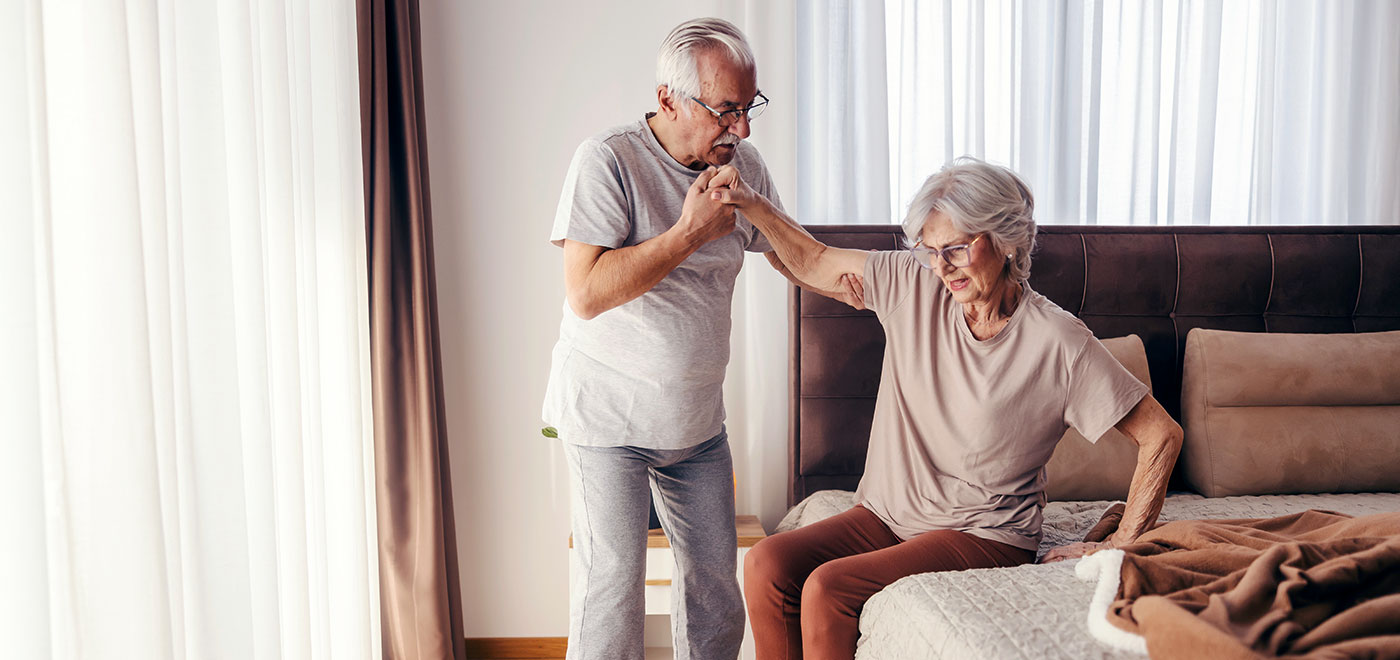Caregiver Lifting: Safe Techniques to Prevent Injury When Caring for Loved Ones
Caregiver Lifting: Safe Techniques to Prevent Injury When Caring for Loved Ones

When was the last time you had to lift your loved one out of bed or a chair? Did it make you wonder if you were going to end up in bed yourself with a bad back? Because caregiving can be such a strenuous physical activity, learning proper body mechanics for caregivers is essential to ensure you don’t hurt yourself in the process.
There are simple steps you can take to increase your strength and flexibility while ensuring both your safety and your loved one’s wellbeing. Even if lifts and transfers aren’t part of your daily routine, knowing how to protect your back is vital for caregiver injury prevention.
Ensuring a Safe Environment
A key element in lifting your loved one safely is creating a home environment that’s accessible, comfortable, and free of hazards. “The physical environment should support the caregiver lifting, not hinder it,” says Judith Sexton, foundation administrator for Home Instead Senior Care.
For optimal home safety for caregivers, consider these improvements:
- Remove loose rugs and clutter from pathways
- Arrange furniture to create wide, clear paths for movement
- Install grab bars in bathrooms and other transition areas
- Ensure adequate lighting throughout the home
- Consider a hospital-style adjustable bed to reduce bending
Maximizing accessibility and comfort levels supports both the caregiver and care recipient, creating a foundation for safe caregiving tips to be effectively implemented.
Learning Proper Body Mechanics
“Body mechanics” describes how we use our bodies when moving and lifting. The goal is efficient, safe movement that prevents injuries. Incorrect positioning creates excessive stress on muscles and joints, leading to accumulated damage over time.
Key Principles
To achieve proper body mechanics for caregivers, focus on these essential principles:
- Maintain proper posture while standing, sitting, or lying down to minimize physical stress
- When standing, keep your head upright with your chin gently tucked—imagine a string pulling straight up from the top of your head
- Wear supportive, low-heeled shoes to maintain correct posture and reduce lower back tension
- Use supportive chairs with armrests when sitting, and consider a lumbar cushion to maintain your spine’s natural curves
- Engage your core muscles when performing any lifting activity
You’ll be surprised at how much better you may begin to feel just by incorporating these simple back pain prevention for caregivers tips into your daily routine.
Safe Lifting Techniques
When it comes to caregiver lifting, proper technique is everything. Follow these safe lifting techniques to protect yourself from injury:
- Plan before lifting: Assess the situation, remove obstacles, and communicate clearly with your loved one about what you’re going to do
- Position yourself correctly: Stand close to the person with your feet shoulder-width apart for a stable base
- Bend your knees, not your back: Keep your back straight and use the strength in your legs
- Tighten your core muscles: Engage your abdominal muscles to provide back support
- Lift smoothly: Avoid jerky movements and lift with a steady, controlled motion
- Pivot, don’t twist: Turn your entire body by moving your feet instead of twisting your back
- Keep the weight close: Hold your loved one close to your body to reduce strain
Common mistakes to avoid when implementing lifting techniques for seniors include:
- Leaning forward from your hips during standing activities like washing dishes or dressing—this strains your lower back, neck, and shoulders
- Standing in fixed positions for too long without shifting weight
- Lifting with your back instead of your legs
- Twisting while lifting or carrying weight
- Attempting to lift someone who is too heavy for you without assistance
Improving Strength and Flexibility
Caregiver fitness plays a crucial role in your ability to safely provide physical care. Maintaining and improving muscle strength and overall flexibility significantly diminishes your risk of injury.
Consider these simple strength and flexibility exercises to support your caregiving role:
- Walking: One of the easiest ways to get exercise and control weight
- Squats or lunges: Strengthens leg muscles used in lifting
- Back extensions: Improves posture and strengthens back muscles
- Core exercises: Planks and modified sit-ups strengthen abdominal muscles
- Arm strengthening: Using household items like soup cans or water bottles as weights
- Stretching: Regular stretching improves flexibility and range of motion
Even small amounts of activity can make a significant difference in your physical strength for caregivers. Consider stretching during television commercials or taking short walks around your neighborhood when possible.
Taking Care of Yourself
Caregiver health requires attention to more than just physical technique. Family caregivers should examine their general fitness level and lifestyle choices, establishing realistic goals for improved wellness.
Along with physical activity, remember these essential aspects of caregiver wellness:
- Balanced nutrition: Ensure adequate calcium and protein intake for strong bones and muscles
- Hydration: Drink plenty of water throughout the day
- Adequate rest: Prioritize quality sleep to support physical recovery
- Stress management: Implement caregiving stress relief techniques like deep breathing or meditation
- Regular breaks: Schedule short respite periods throughout your day
Incorporating a caregiver exercise routine doesn’t have to be time-consuming or expensive. The key is consistency—doing something, no matter how small, to keep yourself moving and maintain your physical wellbeing.
Knowing When to Ask for Help
An important aspect of caregiver safety is recognizing when you need assistance. Asking neighbors or friends to help with lifting tasks can prevent potential injuries and provide much-needed support.
Mobility assistance devices can significantly reduce your risk of injury. Consider these helpful tools:
- Transfer belt for caregivers: Provides secure handholds when helping someone stand or move
- Slide boards: Allow smoother transfers between surfaces
- Mechanical lifts: For situations where manual lifting isn’t safe
- Grab bars: Provide stability in bathrooms and other areas
- Raised toilet seats or shower chairs: Reduce the distance needed for transfers
If you do sustain an injury while providing care, don’t dismiss it. Seeking prompt medical attention should be a priority, as most problems can be resolved with appropriate treatment. Consider consulting with a physical therapy for caregivers professional who can provide personalized guidance on proper lifting techniques.
The physical demands of caregiver lifting require attention to proper technique, environmental safety, and personal fitness. By implementing the safe lifting techniques and body mechanics for caregivers outlined above, you can significantly reduce your risk of injury while providing quality care for your loved one.
Remember that preventing caregiver injuries is essential not just for your wellbeing, but for your ability to continue providing care. Taking proactive steps today to protect your physical health ensures you can be there for your loved one tomorrow and beyond.



